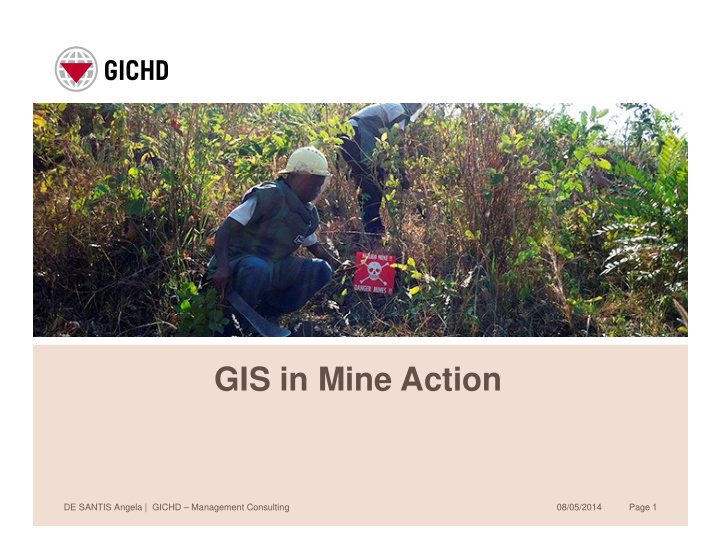



GIS in Mine Action GIS in Mine Action DE SANTIS Angela | GICHD – Management Consulting 08/05/2014 Page 1
Five pillars of Mine Action Humanitarian Advocacy Mine Risk Education Victim Assistance Victim Assistance Stockpile Destruction Stockpile Destruction DE SANTIS Angela | GICHD – Management Consulting 08/05/2014 Page 2
The Global Landmine and ERW Problem DE SANTIS Angela | GICHD – Management Consulting 08/05/2014 Page 3
GIS and RS in Mine Action DE SANTIS Angela | GICHD – Management Consulting 08/05/2014 Page 4
GIS and RS in Mine Action • Effective decision-making in mine action is driven by geographic factors geographic factors INFRASTRUCTURES POPULATION DISTRIBUTION VEGETATION SHA / CHA TERRAIN MI NES/ ERW MI NES/ ERW I MPACT DE SANTIS Angela | GICHD – Management Consulting 08/05/2014 Page 5
Applications in Mine Action • generate intuitive maps at various scales, eg, for operators in the field and for strategic eg, for operators in the field and for strategic stakeholders at country level • • increase increase the the accuracy accuracy of of area area size size m 2 calculations • improve prioritisation and planning of field operations • help model the nominal operational difficulty of demining and determine which assets are suitable for a given task suitable for a given task DE SANTIS Angela | GICHD – Management Consulting 08/05/2014 Page 6
Main info shown in 2D overview maps • Geographic location of hazards, population, IDPs, infrastructures, working teams • Historical information about hazardous areas • • Local conditions: terrain, Local conditions: terrain, weather, accessibility, traffic, security, logistical constraints • • Task management: number and Task management: number and Representation of every hazardous area Representation of every hazardous area by a polygon delimiting its boundaries, type of assets deployed in an area and/or by a point symbol marker at its central XY coordinates DE SANTIS Angela | GICHD – Management Consulting 08/05/2014 Page 7
Base map for planning purposes DE SANTIS Angela | GICHD – Management Consulting 08/05/2014 Page 8
Mine presence/absence Indicators Road/path not longer in use (Bosnia & Herzegovina) 1996 2005 DE SANTIS Angela | GICHD – Management Consulting 08/05/2014 Page 9
Mine presence/absence Indicators Land use change (Bosnia & Herzegovina) 2005 2011 DE SANTIS Angela | GICHD – Management Consulting 08/05/2014 Page 10
Land use change maps DE SANTIS Angela | GICHD – Management Consulting 08/05/2014 Page 11
Activity maps DE SANTIS Angela | GICHD – Management Consulting 08/05/2014 Page 12
Contamination density maps DE SANTIS Angela | GICHD – Management Consulting 08/05/2014 Page 13
3D analysis • Easy generation of 3D surfaces using RS data and GIS tools GIS tools • Advantages of the 3D analysis: – increase the accuracy of area size calculations of contaminated surfaces; – more realistically assess the operational difficulty of demining in a region by integrating slope and demining in a region by integrating slope and elevation into the analysis; – better prepare field operations; – determine the potential location of mines that may – determine the potential location of mines that may have moved over time through water run-off or surface movement; and – report on demining activities in a more visually – report on demining activities in a more visually intuitive manner. DE SANTIS Angela | GICHD – Management Consulting 08/05/2014 Page 14
DE SANTIS Angela | GICHD – Management Consulting 08/05/2014 Page 15
Example of 3D map DE SANTIS Angela | GICHD – Management Consulting 08/05/2014 Page 16
Analysis of accessibility • • Best route between two points Best route between two points according to terrain conditions (slope, land cover, road quality), season, temporary/permanent season, temporary/permanent blockages, hazardous areas • Improvement of the logistical efficiency • Applicable to road clearance management (analysis of impacts) impacts) DE SANTIS Angela | GICHD – Management Consulting 08/05/2014 Page 17
Prioritising Activities and Evaluating Costs Evaluating Costs • • Combining different data sources and spatial relationship between Combining different data sources and spatial relationship between features (i.e. proximity) to: – prioritise hazard clearance – prioritise hazard clearance – determine time and effort for clearance by integrating local terrain and infrastructure conditions – decide most suitable asset by comparing different scenarios under similar – decide most suitable asset by comparing different scenarios under similar terrain conditions; – have better knowledge of the accessibility of a hazardous area – assess the degree of clearance difficulty on the basis of quantifiable terrain – assess the degree of clearance difficulty on the basis of quantifiable terrain criteria (cost evaluation) DE SANTIS Angela | GICHD – Management Consulting 08/05/2014 Page 18
5D:Determining and Displaying the Degree of Operational Difficulty of Degree of Operational Difficulty of Demining DE SANTIS Angela | GICHD – Management Consulting 08/05/2014 Page 19
Low difficulty Medium difficulty High difficulty Very High difficulty DE SANTIS Angela | GICHD – Management Consulting 08/05/2014 Page 20
Multi Criteria Analysis (MCA) INFRASTRUCTURES POPULATION DISTRIBUTION DISTRIBUTION VEGETATION SHA / CHA TERRAIN SPATIAL PROXIMITY PROXIMITY DE SANTIS Angela | GICHD – Management Consulting 08/05/2014 Page 21
Several options… • MASCOT : mine action scoring tool (GICHD-UNIGE) http://www.unige.ch/sig/outils/MASCOT.html • GIS-based Multi-Criteria Analysis of priority selection in humanitarian demining- EU funded Tiramisu project http://tiramisu.maps.arcgis.com/home/ http://tiramisu.maps.arcgis.com/home/ DE SANTIS Angela | GICHD – Management Consulting 08/05/2014 Page 22
Conclusions Advantages of RS and GIS – Low risk – Low cost ** – Multitemporal – Consistent – Consistent – Objective – Systematic – Systematic DE SANTIS Angela | GICHD – Management Consulting 08/05/2014 Page 23
DE SANTIS Angela | GICHD – Management Consulting 08/05/2014 Page 24
Recommend
More recommend